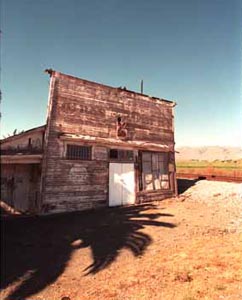Shortly after the January 8th shootings,
I lamented that this would be the first thing people would think of when they heard the word "Tucson," Like Oklahoma City, we'd become a synonym for a tragedy, since the city hadn't distinguished itself in any other notable way. But yesterday I saw
an extraordinary film that not only celebrates the best of Tucson, but nails its essence for anyone who's never had the good fortune to visit here.
Flor de Muertos thrums with the pulse of Tucson, celebrating its unique nature as the confluence of two powerful and confounding cultures. If, ultimately, the filmmakers have cast their nets too widely, there is nonetheless a very impressive catch hauled aboard. Either Lisa Rinzler's stunning and evocative cinematography or
Calexico's vibrant and emotional soundtrack could stand on its own as one of the pillars of a mighty achievement. The problem is,
Flor de Muertos is really two movies.
The first is an exploration of two celebrations: the traditional Mexican
Dia de los Muertos, and Tucson's unique
All Souls Procession. The latter was filmed in its 20th anniversary incarnation, which culminated with a concert from our
justifiably renowned hometown heroes.
This is what director Danny Vinik initially sought to capture: a Calexico concert film, with proceeds to benefit
the nonprofit that organizes the Procession. But in so doing, he and his crew began to make a second film which arose from exploring the cross-border attitudes towards mortality. The second film is about the border itself, and the deaths that are happening on either side, from the violence of the drug war in the south, and the arduous desert crossings of the migrants in the north.
These two films inevitably complement each other, and inevitably crowd each other out. The focus on the celebrations and the music omits the richness of the debate over border issues, and each community's response to the xenophobia and violence. The articulate talking-heads interviews (with journalists Charles Bowden and Margaret Regan) feel both too short and too long. And at the same time, by wading into these contentious waters, the film gives short shrift to the vibrancy and spirit of the All Souls Procession – though the filmed performance finale is breathtaking, the civilian parade participants are largely unheard from.
The Procession began with a creative mourning ritual by artist Susan Johnson and a few friends in 1990, and has grown to include 20,000 spectators/participants each November. Part
Dia de Los Muertos celebration, part Burning Man audience participation event, part Halloween parade, and part avant-circus spectacle, the weekend of events is utterly Tucsonan, a reflection of the best of what it means to live in this particular place. The parade and finale includes the work of professionals like
fire acrobats Flam Chen,
Taiko drumming troupe Odaiko Sonora,
experimental puppeteer Matt Cohen,
circus arts educators Rhythm Industry, and
trip-rock feedback artisans Ensphere. Exploring this in greater depth is the movie that got away – but beyond the organized aspect of the event, the heartfelt contributions from volunteer parade participants are intrinsic to its spirit and success. Particularly poignant in the 2009 Procession, but barely glimpsed in the film, were the tributes to mistakenly slain jaguar
Macho B and recently deceased newspaper the
Tucson Citizen.
As a concert film,
FdM is incomparable, and rightly places the band's singular "
desert noir" regional identity in the context of a nurturing and tight-knit community of kindred musicians, artists and performers. Calexico, resplendent in their own skeleton costumes and makeup, are joined by
simpatico guest artists like
Salvador Duran,
Amparo Sanchez,
Gabriel Sullivan and the
Molehill Orkestrah. The richness of this sonic landscape and its resonance with the themes explored by the camera strengthen the heart of the film despite its overambitious thematic multiplicity.
Producer Douglas Biggers explained that the screening I saw was a 90-minute "directors cut" that will eventually be pared down to an hour in hopes of wider distribution. He mentioned that if the project breaks even, a portion of the profits from DVD sales will go to benefit the organizations that nurture this annual burst of creativity and emotion. I'm hoping that more of the hundreds of hours of footage can be included as bonus material, even as the film itself comes into sharper focus. But there's also an ongoing opportunity for Vinik – or another filmmaker – to delve deeper into the cross-border response to the twin crises infecting our communities, or the amazingly symbiotic artistic meditation on mortality that these communities have evolved. Because to truly do justice to either story takes more than one movie.






























